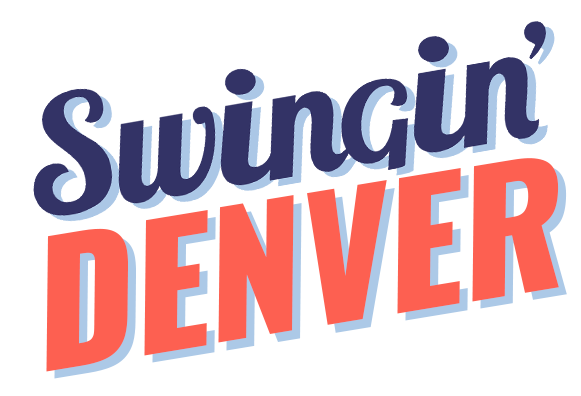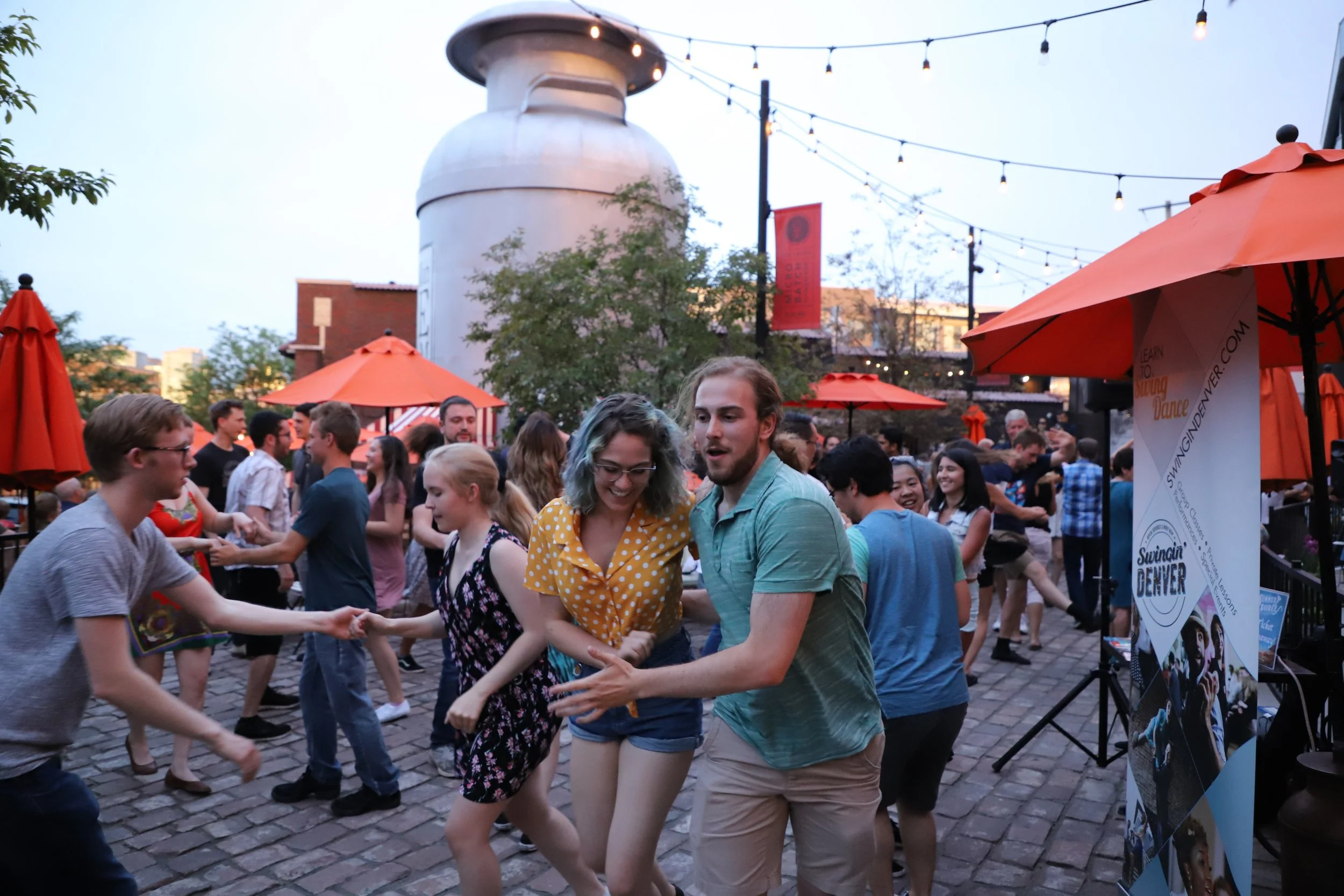Let’s talk about bands! I fielded quite a few questions last night during the SmokeTone Swing Band show about how I find my bands and what my criteria is for booking them at Savoy Denver.
New COVID Mitigation Policy for Savoy Classes
We are modifying our COVID Mitigation Policy for our October class sessions only. Due to an ever-changing landscape concerning COVID cases and individual decision-making concerning the recent bivalent boosters, we are now waiving past requirements for vaccination proof and solely requiring that students wear a fitted mask, preferably an N95 or equivalent over their mouth and nose, while in class.
Asking Each Other To Dance
Last night I had to remind myself to ask a private lesson student to dance. Clearly, the implication, the implied “yes,” is present since, as a student, you’re there to learn to dance and likely dance with the instructor. However, it’s quite important for instructors to model asking a person to dance to give opportunity for consent or “no.” That ought to be true in group classes, private lessons, and socials.
As consent came to be a larger topic within the global swing dance community, hip instructors made sure they discussed how to ask (preferably with your words), that declining a dance is okay, suggesting how to decline, and letting people know that saying just “no” is a perfectly fine response inside of classes and sometimes during socials. When dealing with safe space issues, we would find that offenders typically started out by crossing boundaries like not accepting “no” and forcing one to dance through verbal and physical means. This sometimes led to further harm and emphasized why we ought to have conversations revolving around consent sooner. And it’s quite good for the people in power like the organizers and instructors to model this from the beginning.
It might take time recalibrating current habits, but with a bit of self-awareness and effort, it’s worth it. Students watch you and take note. It’s good to be a responsible leader within the community.
DJ Music is Practice Music?
“Remember that DJ music is for practice; live music is game time.” I found myself reflecting on Falty’s words yesterday during the Vail Jazz Festival as I was listening to all the band members’ various solos. Whereas DJ’ed music features music frozen in time, live music is breathing right in front of you, bringing you a unique once-in-a-lifetime experience that you, the dancer, are reacting to in real-time. It truly is game time!
Discovering this video earlier this year may have unduly influenced me to solely focus on live music programming at The Savoy Denver. And we feature so much live music throughout the year with our various event partners, so be sure to bookmark our calendar and subscribe to our newsletter so you can stay apprised of all our live music happenings.
How To End A Class On Time
Providing Students Agency
Pottery & Lindy Hop - Philosophies Merge
Today I attended the O’baware Summer Sale in Lafayette. Not only did I find excellent pottery to purchase, but I had the opportunity to listen to Kazu Oba, the Japanese-trained pottery artisan, talk about his methods and philosophy.
One particular element struck me was when he was talking about the piece pictured in this blog and I’ll try to be accurate as much as possible with this retelling. This particular piece is shaped cylindrical on the wheel with the vertical lines representing Kazu’s fingers as he draws the material upward. At some point he slices this cylinder into three pieces and drops the wet clay from a slight height for it to flatten.
However, the clay remembers that it was round and part of a whole so it tends to recoil round, so Kazu must work it flatter, but you’ll still see the edges curl upwards. The clay remembers.
This is in contrast with other potters that might start with a flatter piece of clay and try coiling the ends. However, Kaza was saying something akin to him not wanting to impose his will on the clay. He prefers his method of providing the clay a memory and guiding that memory to form something unique. This was my takeaway.
This led me to reflect briefly upon dance teaching. While these thoughts aren’t fully formed, I’d say there is a remarkable difference between how I was trained to teach ballroom dance (specific foot placement, specific technique, specific syllabi, imposition of will) versus how we teach Lindy Hop (acknowledging ambiguity, welcoming expression, striving to improve those triple step rhythms and moving from core). You can bring your lived experiences to vernacular dance and they can inform your interpretation of your teachers’ expressed philosophies whereas ballroom (I’ll acknowledge not all) can be cookie-cutter and formulaic.
Sometimes one style works best for a person. Sometimes you start with ballroom and move to Lindy Hop, sometimes you move the other direction. And I think it’s good to offer options so dance can meet people where they are at.
The Dance is Called Lindy Hop
Here's an excerpt from a conversation about urban dance that we can see reflected in current naming struggles within the Lindy Hop community. "Urban is problematic because it is not a racial term. It eliminates race. You're taking away the people from the dance."
You can likely draw a line from this statement to swing schools and instructors utilizing terms such as "jitterbug" or "east coast swing" to label classes teaching Lindy Hop with slow and quick rhythms. Whether their intentions are good or not, the more we get away from the origins, the more we erase Black ownership. And, while names change as things evolve, what people call "east coast swing" or "jitterbug" was a devolving or simplification of Lindy Hop.
Swingin' Denver has long since scrapped our own Jitterbug classes, but up until 2019, we had called the beginner swing dance classes we taught at outdoor events "beginner swing dance," jitterbug" or "east coast swing." We did not call it Lindy Hop.
Only after a lot of reading and listening during the pandemic did we make the switch which has been even more emphatic this year. My thoughts and feelings had finally firmly coalesced that we would confidently state we are teaching Lindy Hop with its vernacular dance hallmarks while teaching a particular rhythm (slows and quicks) danced to excellent swing music.
I'm happy to be in this spot since we are now more consistent with what we offer, believe and support. We could not celebrate Lindy Hop, a Black social dance, in one hand and erase the Black origins in the other.
We still have more growing and learning to do, but I wanted to share these thoughts with our audience. I hope other swing dance school will reach these conclusions soon.
When Might COVID Mitigation Policies Change?
10-3-22 Update:
From speaking with others in the Denver swing community that I respect for their evidence-based approach concerning COVID mitigation policies and data shown HERE, we are waiving the vaccination/immunity requirement for our dance parties. Whereas classes still require mask usage, masks will be optional at our October 5 dance. This is subject to change for our November 2 dance party.
9-28-22 Update:
Due to infection rates, statistics regarding acceptance of second boosters pre-bivalent and bivalent, individual self-reported decision-making, and advice from a respected epidemiologist, we have decided to remove proof of possible immunity from immune-competent individuals for our classes. To stay true to our goals of low to no transmissions, our mask policy does remain in place as our sole COVID transmission control.
Our COVID mitigation policies remain in place for our October 5 dance.
From 7-7-22:
We’ve been receiving more inquiries about our COVID mitigation policies, so I wanted to take a moment here to address what they are, why they exist, and what we look at when evaluating if they might change.
In its simplest form, our policies require that a person either provides one of the following for our indoor happenings:
proof of a booster
proof of being vaccinated with a two-dose regiment (Moderna or Pfizer) within the past 6-8 months
proof of antibody levels > 1,000
One of these three is sufficient. Then we require masks for our classes and encourage masks for our dances. One of our primary goals is to run events, including dances and classes, with low to no transmissions. Because students have to interact with most their fellow students, we require the masks in that environment; whereas at parties dancers can readily decline dances.
Now let’s get into what would make us change our policies whether that is stricter or looser. One great resource is the COVID-19 dial dashboard for Colorado seen HERE. At the time of this blog’s publication, metro Denver counties and Denver are in rough shape with average positivity 12+% and 1 in 42 to 55 Coloradans are infected. The latter statistic comes from Colorado’s modeling team and published here.
Because, based on the June 23 modeling report, Colorado’s numbers had likely peaked, we chose to keep encouraging mask usage at our July 6 dance rather than making them mandatory. Since everyone who enters must be up to date according to CDC guidelines, or slight latecomers to being vaccinated, we felt confident we’d minimize transmission with the controls we have in place.
If we wanted to loosen our policies, we would likely need to the Colorado dial dashboard achieve Green Level and stay there. We’d also need to see better news from the Colorado modeling team. Right now, the new BA variants seem to be highly infectious though less severe than the delta variant. That mix of news makes it harder to forecast policies. What would help is if people eligible to be vaccinated and boosted (while recognizing that some immuno-compromised people are ineligible), would follow those guidelines and help our global community reduce the spread of COVID.
Keyword Trends - Lindy Hop vs Swing Dance vs Jitterbug
My first prominent swing dance instructor once told me to teach Shim Sham in the group class starting on the “1” because it’s easier. That explanation made ready sense to me as a newer dance teacher. Most, if not all, dances taught at this ballroom studio with the only all-ages swing dance in metro Kansas City started on the “1.” It never occurred to me that, as a dance educator, I could make finding the “8” easier for students. It did mean the Shim Sham was a hot mess when Frankie Manning came to town and led everyone in it (note: As I anticipated this train wreck, I hit “play” on the song and just watched).
I feel the same entrenched reasoning might exist for vernacular dance instructors still billing classes as “jitterbug” or “east coast swing.” These are marketing terms popular back in the late 1990s and early 2000’s when neo-swing was on the rise and white dance instructors, like mine in KC, saw those words as a way to get new students to gravitate toward their classes and swing nights.
Even here we used “Jitterbug” as a way to label drop-in classes at the Arvada Tavern 6-7 years ago. Our thought process was akin to “if the Mercury Cafe, seen as the OG’s of the scene, is using it to sell classes, why not us?” Well…
Google Trends shows that people want to learn how to swing dance, specifically Lindy Hop. Even Instagram hashtag usage shows us what captivates people. Plus, as the below image shows, most people search “Jitterbug” for the cellular phone which debuted in 2006. Besides, maybe people just inherently know that a jitterbug just isn’t that cool unless you’re in specific regions like LA or Las Vegas where being a jitterbug is a badge of honor. Otherwise, “Jitterbug is primarily the white ghosting of a black dance,” a white thing and not as smooth as lindy (Frankie Manning in Margaret Batiuchok’s dissertation), uncouth, and an alcoholic drink giving you the jitters.
So, if you purport to teach swing dance within the vernacular scene (Vernacular refers to dance performed to the rhythms of African American music: dance that makes those rhythms visible - “Steppin’ on the Blues” by Jacqui Malone), then I’d highly encourage teachers to:
Specifically name what you’re teaching whether that’s Lindy Hop, Balboa, Collegiate Shag, Vernacular Jazz, Charleston, etc
Stop billing classes as Jitterbug or East Coast Swing. To borrow from Margaret Batiuchok’s dissertation once again - Jitterbug means different things to different people. Lindy means one thing. And East Coast Swing belongs to the ballroom dance community and was stripped of pretty much all vernacular values
Make it easier for people to find Lindy Hop and other vernacular dances. By appropriating Lindy Hop and other Black dances, and renaming them to suit your needs, you’re making it harder for people to find Lindy Hop and discover the tenets of vernacular dance.
The main reason why I think people stumble over Lindy Hop’s varying pattern lengths and varying rhythms (triple steps, stomp offs, slows, quicks, etc) is because of dance instructors billing patterns using slows and quicks as east coast swing or jitterbug. This leads to a dissonance where dancers think these rhythms and some patterns live on islands separate from swingouts or triple steps, for example.
If you’re dancing with vernacular dance hallmarks and striving to impart these characteristics such as improvisation and spontaneity, propulsive rhythm, call-and-response patterns, self-expression, elegance, and control to your students while dancing to solid swing-era music, you ought to calling what you’re teaching Lindy Hop. Just do it.








